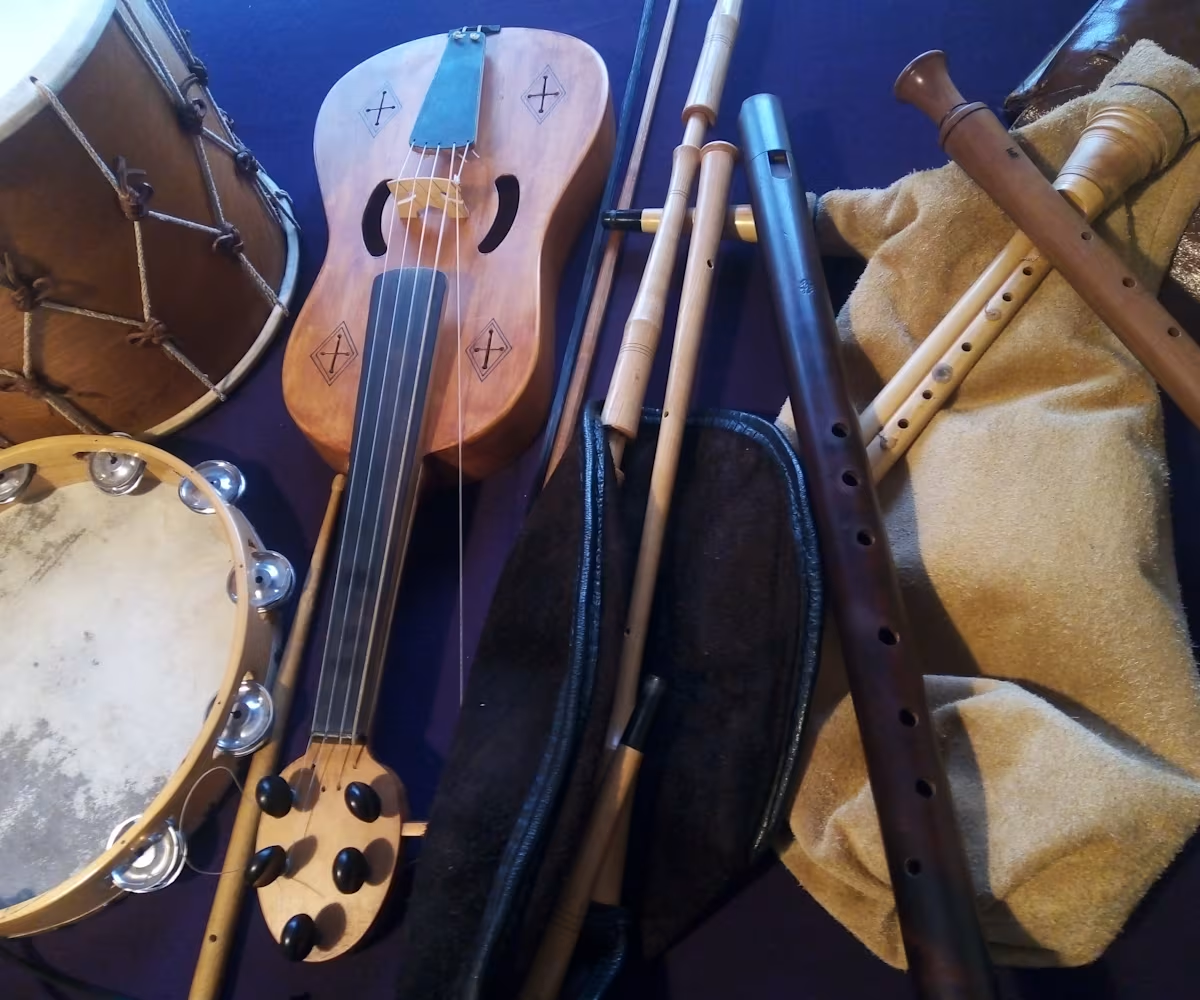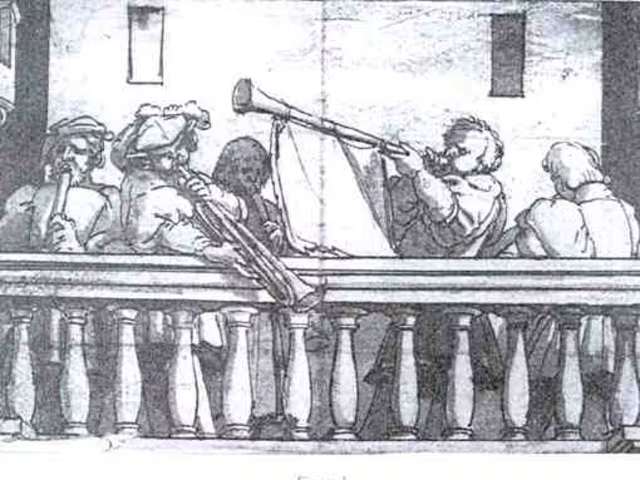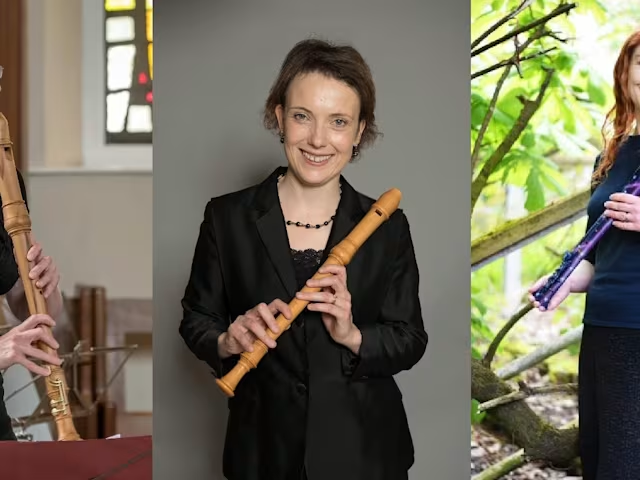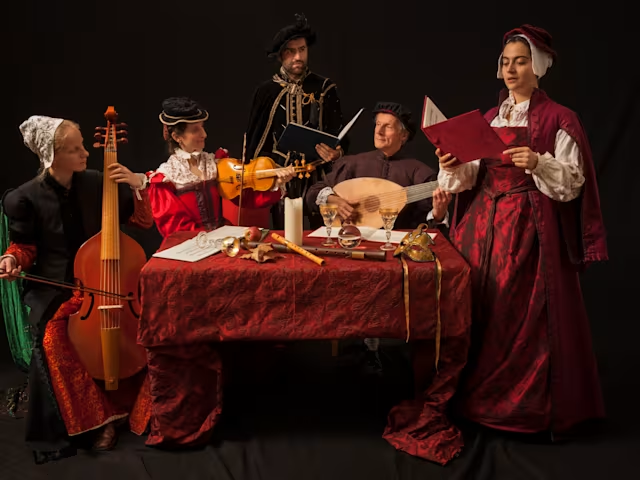Consort of 1
The Medieval Imaginarium
Consort of 1 live-looped Medieval (and ancient) Music

Lizzie Gutteridge uses her live-looping, combined with a wide range of historical instruments, including aulos, bagpipes, recorders, fiddles and percussion, to explore the imaginary world conjured up by these images and sources.
Some examples:
-The compositions of Mesomedes, composer to the Roman Emperor Hadrian, only survive because they, along with the theoretical treatise on ancient Greek musical notation, were copied over and over, handed down through the centuries by scribes and monks. The oldest surviving copies we now have are from the 13th century. So did medieval monks ever sing or play these tunes which were already 1000 years old?
-In the German town of Augsburg, in the first few decades of the 16th century, a fascinating tradition took place. Each year the town's dignitaries would dress up in historical costumes, representing their forbears from the 1200s through to their own time. They performed processions and dances and even commissioned paintings of the occasion where the people are labelled by name along with the dates they represent. In one of these paintings, from 1522, we can see the Stadtpjeiferen (the town band, or Waits, as they were known in England), with their alta capella instruments, who are joined by a lutenist, a bagpiper and a drummer. What did they play? Was it the latest hoftanzen or did they try something much older?
-When Barnaba de Modena painted the coronation of the Virgin Mary in 1374, he showed her surrounded by a host of musical angels with trumpets, fiddle, lute, organ, shawm, bagpipe and aulos. What might that band have sounded like in the artist's head? What tune was he humming to himself as he plied his paintbrushes?
 Colchester Early Music
Colchester Early Music Sun, 23 November 2025
Sun, 23 November 2025 St Andrew's Church, Marks Tey
St Andrew's Church, Marks Tey 2:30pm
2:30pm £15 (conc. available)
£15 (conc. available)- ➕1 other performance
Full Event Details

Paintings from the Middle Ages are often used to back up research into historical performance practice, and yet they also show a world far beyond the reality of Medieval life: weird creatures, animals playing instruments, historical events from centuries before the lifetime of the artist, and combinations of instruments that defy the theoretical musical teachings of the day.
Lizzie Gutteridge uses her live-looping, combined with a wide range of historical instruments, including aulos, bagpipes, recorders, fiddles and percussion, to explore the imaginary world conjured up by these images and sources.
Some examples:
-The compositions of Mesomedes, composer to the Roman Emperor Hadrian, only survive because they, along with the theoretical treatise on ancient Greek musical notation, were copied over and over, handed down through the centuries by scribes and monks. The oldest surviving copies we now have are from the 13th century. So did medieval monks ever sing or play these tunes which were already 1000 years old?
-In the German town of Augsburg, in the first few decades of the 16th century, a fascinating tradition took place. Each year the town's dignitaries would dress up in historical costumes, representing their forbears from the 1200s through to their own time. They performed processions and dances and even commissioned paintings of the occasion where the people are labelled by name along with the dates they represent. In one of these paintings, from 1522, we can see the Stadtpjeiferen (the town band, or Waits, as they were known in England), with their alta capella instruments, who are joined by a lutenist, a bagpiper and a drummer. What did they play? Was it the latest hoftanzen or did they try something much older?
-When Barnaba de Modena painted the coronation of the Virgin Mary in 1374, he showed her surrounded by a host of musical angels with trumpets, fiddle, lute, organ, shawm, bagpipe and aulos. What might that band have sounded like in the artist's head? What tune was he humming to himself as he plied his paintbrushes?
Venue Details & Map

Location
St Andrew's Church, Marks Tey
Church Lane Marks Tey CO6 1LW
Other performances
In addition to the performance listed above, this concert will also be performed as follows:
Show past performances of this programme
Related upcoming events

Christmas with the Colchester Waits
The Colchester Waits
 Sun, 14 December 2025
Sun, 14 December 2025 St Andrew's church, Marks Tey
St Andrew's church, Marks Tey 7:30pm
7:30pm £15 (£10 concessions), UNDER 18s FREE
£15 (£10 concessions), UNDER 18s FREE Colchester Early Music
Colchester Early Music

Renaissance Instruments Workshop
Stephanie Dyer
 Sat, 17 January 2026
Sat, 17 January 2026 St Andrew's Church Hall, Marks Tey
St Andrew's Church Hall, Marks Tey 10:00am
10:00am £5 - £25
£5 - £25 Colchester Early Music
Colchester Early Music

Sackbut Soliloquy
Stephanie Dyer
 Sun, 18 January 2026
Sun, 18 January 2026 St Andrew's church, Marks Tey
St Andrew's church, Marks Tey 2:30pm
2:30pm £15 (£10 concessions), UNDER 18s FREE
£15 (£10 concessions), UNDER 18s FREE Colchester Early Music
Colchester Early Music

Triple tapestries
Mosaic recorder ensemble
 Sun, 1 February 2026
Sun, 1 February 2026 St Andrew's church, Marks Tey
St Andrew's church, Marks Tey 2:30pm
2:30pm £15 (£10 concessions), UNDER 18s FREE
£15 (£10 concessions), UNDER 18s FREE Colchester Early Music
Colchester Early Music

The King's Delight
Passamezzo
 Sun, 1 March 2026
Sun, 1 March 2026 St Andrew's church, Marks Tey
St Andrew's church, Marks Tey 2:30pm
2:30pm £15 (£10 concessions), UNDER 18s FREE
£15 (£10 concessions), UNDER 18s FREE Colchester Early Music
Colchester Early Music

